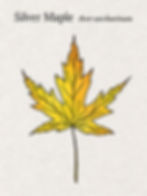How To Identify Maples
- Rock Point Communications
- Oct 28
- 3 min read
Updated: Oct 30
Illustrations & Writing by Lorna Dielentheis, Naturalist & Contributing Writer

Fallen leaves are everywhere right now, providing a lively burst of color and a satisfying crunch underfoot-- a grand finale to the foliated season.

Arguably the most recognizable of these leaves, and certainly the most cherished here in Vermont, are the maples. But did you know they are not all the same?
When thinking of maples, Vermont’s delicious maple syrup is one of the first associations many of us make. But the sugar maple, or Acer saccharum, is just one of many species of maple. Sugar maple, red maple, silver maple, striped maple, and mountain maple are all native to Vermont and have the tell-tale maple leaf shape. There are also cultivated species of maple that are used as street trees. And to complicate matters further, red and silver maples sometimes hybridize (both in nature and as a cultivated species) and produce a maple that has characteristics of both species, called freeman’s maple, or Acer x freemanii.
So, how to tell these maples apart?
Luckily, the three most common maples native to Vermont have distinct leaf features we can use to identify them. And though there are hybrids, street trees and a few other native maples, most of the time if you’re walking in the woods in the Champlain Valley you’ll be encountering these three species.
Sugar Maple, or Acer saccharum

Sugar maples are the easiest of these three species to differentiate, because of a couple of key features:
The sinuses, or gaps between the lobes of a leaf, are u-shaped rather than v-shaped
The leaf margin is sparingly toothed, much less toothed than the margins of both silver and red maples
Additionally, sugar maples have 3-5 lobes, and a pointy brown winter bud (distinct from the rounded red buds of silver and red maples). They can sometimes be confused with the non-native norway maple, or Acer platanoides, but you can tell the two apart by breaking off the leaf stalk– if it’s a norway maple, a whitish, watery sap will flow from the break.
Red Maple, or Acer rubrum

Red maples are easy to tell from sugar maples, but can be more difficult to tell from silver maples and especially from hybrids of the two. There are a few distinct features to look for, though:
V-shaped sinuses distinguish red and silver maples from the u-shaped sinuses of sugar maples
Red maples are toothed around the entire leaf margin, vs silver maples whose teeth are concentrated on the upper portion of the lobe
Red maple lobes are generally thicker than those of silver maples
Silver Maple, or Acer saccharinum

Like red maples, silver maples can be easily distinguished from sugar maples by their v-shaped sinuses and red winter buds. To tell them apart from red maples, you’ll want to look for:
5 narrow lobes, occasionally 7
Irregular teeth concentrated to the upper portion of each lobe
Silvery-white underside (more noticeable in summer but still present in fall)
Keep in mind that both red and silver maples are difficult to distinguish from their hybrid, freeman’s maple.
Once you start to pick up on the distinct look and shape of each of these maples, you’ll be able to tell them apart easily. Here at Rock Point, sugar maples are the most abundant, and we tap them to make maple syrup every year in the late winter/early spring as part of our Community Maple Program.
Interested in maple sugaring with us? Get on our community maple list to receive updates on when tree tapping is happening, and come join in the fun!
Additional Resources:
Curious about the trees on your street? If you live in Burlington, VT, check out the Burlington Tree Inventory
For more detailed tree identification keys, try:
The Forest Trees of Maine by the Maine Forestry Dept. (which is relevant to Vermont and free to download as PDFs)
Woody Plants of the Northern Forest by Jerry Jenkins
Illustrations by Lorna Dielentheis
.png)